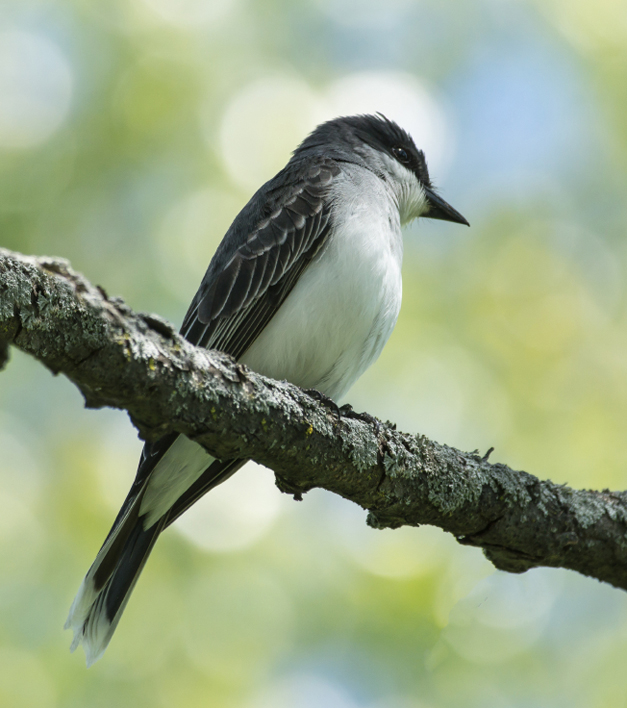Tyrannus tyrannus is the Latin name for the eastern kingbird. The bird lives up to its name. It aggressively defends its territory, even against hawks and other birds much larger than itself. I’ll never forget my husband’s report of being mercilessly attacked by a kingbird – the tyrant! – every time he parked his car near a young tree where a pair had made their nest.

Despite the unflattering moniker, there is something about the eastern kingbird that I find immensely appealing. Partly it’s the appearance: handsome, always erect, sporting charcoal head and back feathers with snow-white underparts and a tail that looks as if it has been dipped in white paint. Partly it’s the sound it makes: a series of sharp, zeeting notes that instantly command attention. And partly it’s the bird’s flycatcher behavior of sallying forth from a field stalk or sapling, then returning directly to the same perch after snagging an insect on the fly.
But mostly, I think it’s the surprising conspicuousness of the eastern kingbird. Most of the flycatchers we see locally – phoebes, pewees, great crested flycatchers and others – are birds of dense shrublands or forests. But the kingbird favors wide open areas where it is easy to spot atop an old milkweed stalk or a fence. Those wide open areas are not confined to the country. Kingbirds nest in trees, usually smaller ones, in parks, golf courses, even along the Chicago lakefront. Before Northerly Island was torn up for its transformation into a multiple-habitat park, a pair of eastern kingbirds regularly built their sturdy, but not-so-neat cuplike nest on the branch of an oak sapling there.
The arrival of kingbirds along the lakefront, or anywhere in Illinois for that matter, is cause for celebration. The birds have found their way, without GPS, from the depths of Amazonia in Colombia and Ecuador, sometimes even from as far away as northern Chile.
In Barrington, you can expect to see eastern kingbirds during late spring and early summer at most of the Spring Creek Forest Preserve restoration sites, at Citizens for Conservation’s Grigsby Prairie and Flint Creek Savanna, at Lake County’s Cuba Marsh. An encounter with Tyrannus tyrannus should fill you with the admiration this species deserves and, hopefully, will not involve a tyrannical attack!
………………………………………………………
About the Author
Wendy Paulson has lived in Barrington Hills since 1975, and has led bird walks in the area for many years. She re-established the Nature Lady program in District 220 and St. Anne’s in the late 70s, under the auspices of The Garden Club and Little Garden Club of Barrington.

Wendy developed the education program for Citizens for Conservation, initiated and edited its newsletter, and has been an active volunteer with CFC for over 30 years.
During interludes in New York City and Washington, DC, she taught classes about birds in the public schools and is helping to develop a similar program in Chicago public schools with Openlands.
She has a regular schedule of bird walks in the Barrington area sponsored by Citizens for Conservation and Audubon Chicago Region.
Wendy is chairman of The Bobolink Foundation, serves on the board or advisory committee of multiple conservation and bird-related organizations, both domestic and international, and is former chairman of IL and NY chapters of The Nature Conservancy.
She and her husband Hank have two grown children and are avid hikers, cyclists, and kayakers.
For more information about a cause close to Wendy’s heart here in Barrington, visit CitizensForConservation.org.
Wendy is also a regular contributor at 365Barrington.com sharing profiles of birds found in the Barrington area. CLICK HERE to read all of Wendy’s posts published in our Birds of Barrington series and watch for her next contribution which will be published early next month.
Do you have a question about birds you’ve seen in Barrington? Just enter you question in the comments box for this post and we’ll ask Wendy!






